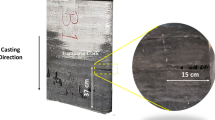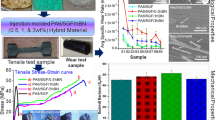Abstract
A study has been conducted examining the thermal fatigue characteristics of an α2/SiC composite; in particular, SCS-6 reinforced Ti-24Al-11Nb (at. pct). The effort included the investigation of the effect of the environment by cycling coated and uncoated specimens in air and in an inert environment. Damage assessment was determined by postcycling room-temperature tension testing as well as by microstructural examination, including both optical microscopy and scanning electron microscopy (SEM). Significant reductions in postcycling tensile strength were observed for coated and uncoated specimens thermally cycled in air from 150 °C to 815 °C for 500 cycles, while no measurable loss of strength was found for specimens cycled in a low-pressure inert environment under otherwise identical conditions. The synergistic effect of residual stresses due to a coefficient of thermal expansion (CTE) mismatch and environment on the degradation of tensile properties of the thermally cycled composite is found to be the critical damage evolution mechanism for both coated and uncoated composites cycled in air. Residual stresses alone were found not to be critical in creating damage that could be tracked by a loss in residual strength.
Similar content being viewed by others
References
M. Khobaib and F.W. Vahldiek: inSpace Age Metals Technol-ogy: 2nd Int. SAMPE Metals and Metals Processing Conf., F.H. Froes and R.A. Cull, eds., Society for the Advancement of Material and Processing Engineering, Covina, CA, 1988, vol. 2, pp. 262–70.
S.J. Balsone: inOxidation of High-Temperature Intermetallics, T. Grobstein and J. Doychak, eds., TMS, Warrendale, PA, 1989, pp. 219–34.
General Electric Staff: inTitanium Aluminide Composites-Interim Report No. 3, Jay Jackson, ed., Air Force Contract F33657-86-C-2136, Wright-Patterson AFB, OH, June 1989, p. 206.
B.N. Cox, M.R. James, D.B. Marshall, and R.C. Addison, Jr.:Metall. Trans. A, 1990, vol. 21A, pp. 2701–07.
S.M. Russ:Metall. Trans. A, 1990, vol. 21A, pp. 1595–1602.
J. Culp: McDonnell Douglas Corporation, St. Louis, MO, private communication, 1989.
I. Roman, S. Krishnamurthy, and D.B. Miracle:Proc. 7th World Conf. on Titanium, TMS, San Diego, CA, 1992, in press.
M.L. Gambone:Fatigue and Fracture of Titanium Aluminides, WRDC-TR-89-4145, Wright Patterson Air Force Base, OH, 1990.
J. Smialek, M.A. Gedwill, and P.K. Brindley:Scripta Metall., 1990, vol. 24, pp. 1291–96.
F.E. Wawner and W.J. Whatley: inSpace Age Metals Technol-ogy: 2nd Int. SAMPE Metals and Metals Processing Conf., F.H. Froes and R.A. Cull, eds., Society for the Advancement of Material and Processing Engineering, Covina, CA, 1988, vol. 2, pp. 470–79.
G. Reynolds: Materials Science Northwest, San Marcos, CA, unpublished research, 1990.
Author information
Authors and Affiliations
Rights and permissions
About this article
Cite this article
Revelos, W.C., Smith, P.R. Effect of environment on the thermal fatigue response of an SCS-6/Ti-24Al-11Nb composite. Metall Trans A 23, 587–595 (1992). https://doi.org/10.1007/BF02801176
Received:
Issue Date:
DOI: https://doi.org/10.1007/BF02801176




